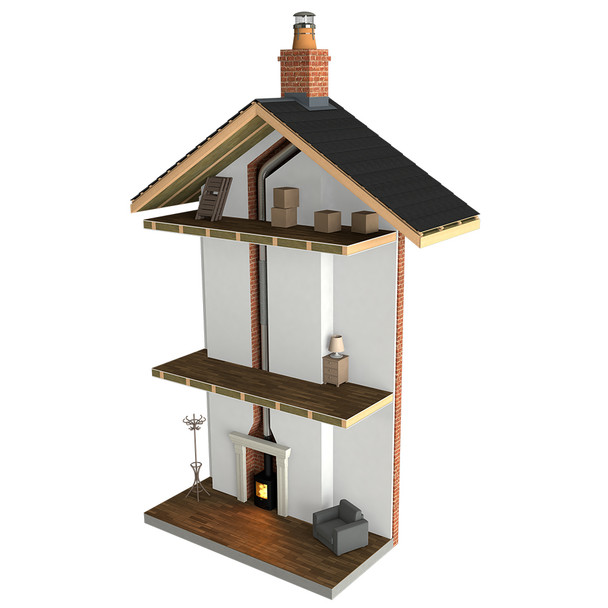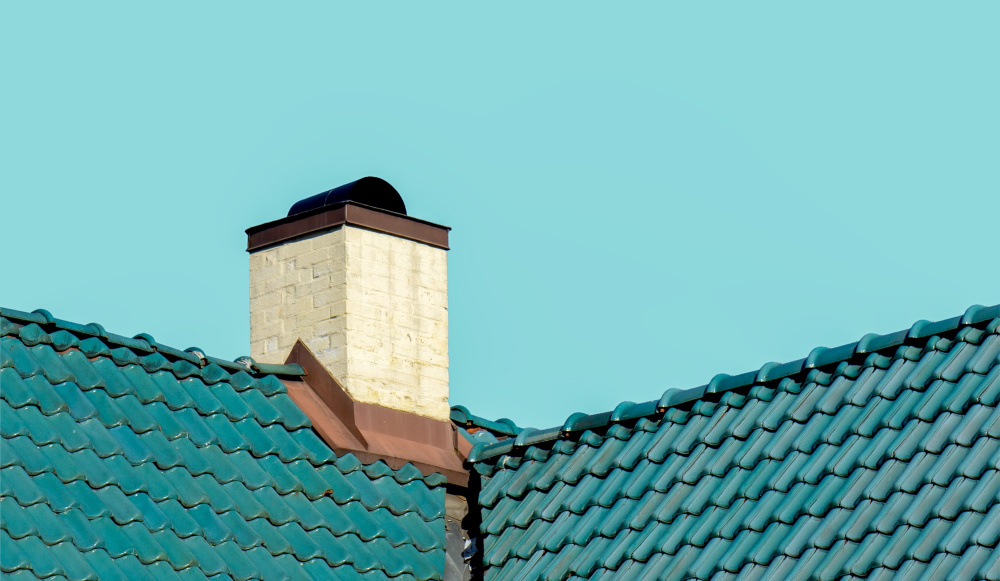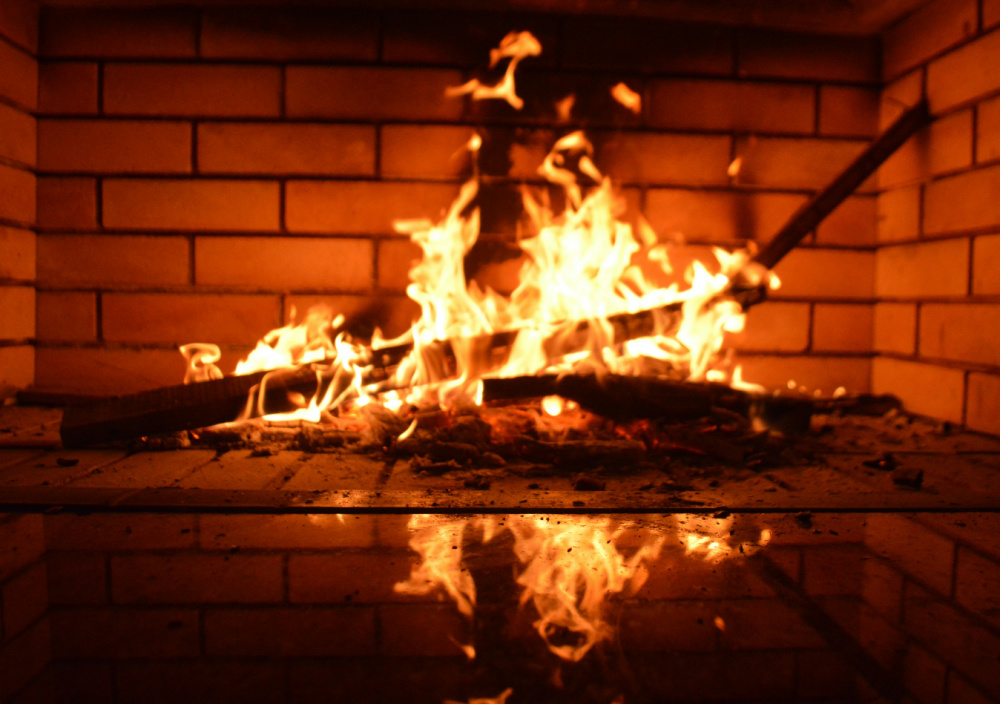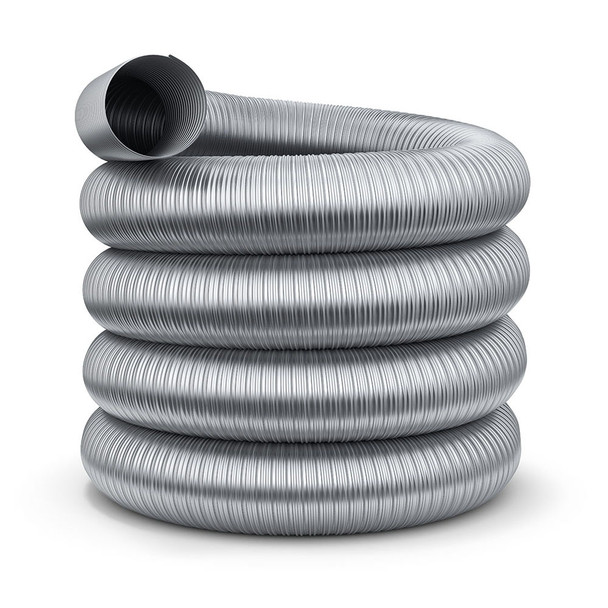How Fitting a Flue Liner Can Save You Money On Your Energy Bills
If you’re thinking about switching to a log burner or open fire as a means of saving on your gas or electricity bills, did you know there’s something else you can do to save money on your energy bills? Fitting a flue liner! Find out more in this latest blog from Trade Price Flues.
What is a flue liner?
If you’re unfamiliar with the term flue liner, it refers to a piece of metal, flexible tubing that stretches from the very top of your chimney (usually hanging from a chimney hanger), all the way down to your fireplace.
Should you be using a wood-burning stove, the flue liner will clamp directly onto the stove-pipe. If you have an open fireplace, the chimney liner will connect to the fireplace chimney gather.

(Example of a flue liner in situ).
Once installed, a chimney liner creates a well insulated ‘tunnel’ through which gases and smoke from your fire or stove can move up the chimney and out, away from your home.
There are many instances in which you will want to install a flue liner in your chimney. For example, if you are creating a new open fireplace in your home, then you’re legally obliged to add a chimney flue liner.
However, even if you’re not legally obliged to install a flue liner (e.g. you have an older home with an existing chimney), we’d strongly recommend that you install one away.
Why? Because, a flue liner will save you money!
How does installing a flue liner save you money?
For many people, the switch to an open fire or log burner will save them considerable sums on their energy bills (especially at the time of writing, when householders are facing the biggest energy bills in British history).
But, adding a flue liner to that stove or fireplace can save you even more money. Here’s how…
Flue liners help your chimney function properly
Fires and stoves work on a common principle - the chimney effect.
A chimney - and fire or stove - works on the principle that hot air rises above cold air as a result of a pressure differential.
When your fire is burning, it heats up the air immediately above it in the chimney cavity. This creates a difference in air pressure between the chimney cavity and the room in which your fire or stove is located.
This difference in air pressure causes the hot air in the chimney to rise up and out of the chimney. As it does so, the pressure differential ‘pushes’ cooler air in the room into the fire.
This is known as the chimney’s draw or draught.
In a properly functioning chimney, this draw becomes an ongoing, perpetual cycle whilst the fire is burning. Hot air is continually rising up the chimney, and cold air is being pushed into the fire.
However, this cycle can become interrupted if your chimney isn’t sufficiently ventilated.
Should your chimney be cold and poorly insulated, this can cool the hot air that is rising from your fire - slowing it down, or even causing it to fall back down the chimney.
In this situation, the draw or draught of your chimney will be completely interrupted - causing your fire to gutter or even completely extinguish.
A chimney liner prevents this, as it keeps the air, smoke, and combustibles rising from your fire warm until they exit your chimney. As a result, a flue liner can help maintain that all important chimney effect.
This results in a properly functioning fire, which burns the right amount of fuel - saving you money on your firewood/fuel bills!
Flue liners make your fire or stove easier to light
With a quality flue liner installed, your open fireplace or wood-burning stove will be much easier to light - saving you money on kindling and firewood.
The reason your fire or stove will be easier to light with a flue liner installed is because of that all-important chimney effect.
A flue liner will ensure that the chimney effect is able to take hold straight away, as soon as you’ve lit your kindling. This allows the fire to ‘take’ much more quickly, allowing you to add your initial logs much sooner.
As a result, you’ll waste less kindling, and you’ll save time!

Flue liners make your fire or stove more efficient
By ensuring a consistent and quality draw/draught, a flue liner will also make your fire or stove more efficient.
For open fires - and stoves in particular - it’s possible for the fire to burn either not enough, or too much.
This generally happens when the fire is either receiving too little, or too much oxygen.
Either way, you’ll find that the firewood doesn’t burn properly.
In the former case, when there is insufficient oxygen, the firewood will give off lots of smoke and will not give off all the heat it’s capable of producing.
In the latter case, when there’s too much oxygen, the firewood will burn fiercely, but much too quickly, meaning you have to replenish the logs on your fire more often.
The result of both instances is that you won’t be making the most economical use of your firewood.
By installing a flue liner, you’ll ensure that your chimney’s draw is working properly, and will allow you to better regulate the amount of oxygen reaching the fire - saving you money on firewood.
Flue liners can reduce the amount of chimney maintenance
A more long-term saving associated with the use of chimney liners is regarding chimney maintenance.
Without a chimney liner, the inside of your chimney cavity will build up deposits of creosote, soot and other combustible materials over time.
Not only does this pose a safety hazard, as these materials are highly combustible, but these build-ups can cause blockages and reduce the performance of your fire.
Removing build up of these materials can be costly.
By installing a chimney liner, you’ll prevent these build-ups occurring, saving you money on expensive chimney maintenance.
Chimney liners effectively create a new chimney cavity within your chimney.
Plus, because quality chimney liners are made from steel, they keep the air and smoke from your fire warm, meaning the smoke and air don’t have a chance to cool down and deposit combustible materials within the chimney liner.
Chimney liners are also easy to clean, with chimney sweeps able to use ball-topped polypropylene brushes to quickly clean a liner.
Flue liners make your chimney safer
Following on from the point above, flue liners make your chimney safer - reducing the likelihood of chimney fires and the resulting costly remediation work that such fires entail.
How?
By preventing the transfer of heat to combustibles.
As we mentioned above, if you’ve been using your fireplace and chimney without a flue liner for a while, it’s possible that combustibles such as creosote have built up within the walls of the chimney cavity.

Should you be burning a fire, and it gets particularly hot, this can lead to super hot smoke and gases passing through your chimney. As they pass build-ups of combustibles, they can transfer heat to them - eventually leading to pyrolysis. This refers to the process whereby a material becomes so hot it spontaneously ignites.
In this situation described above, the result is a chimney fire - which can potentially be life-threatening and result in severe damage to your home.
A flue liner will reduce the chances of this happening as it insulates the heat from the hot gases, preventing the heat from transferring to any combustibles that have accumulated on the walls of the chimney cavity.
So save money and make your chimney far safer with a flue liner!
What flue liner should I use to make my stove/fire more efficient?
Now that you’ve read the ways in which a flue liner can help save you money on your energy bills, it’s time to look at which flue liners will work best for you.
Chimney liners to buy if you burn seasoned wood
Do you only ever burn seasoned wood on your stove or open fireplace? In that case, you’ll need what’s known as a 316-grade flue liner.
These liners, as their name suggests, are made from 316-grade stainless steel. This is a lighter grade of steel, yet it is alloyed with chromium and nickel, making it highly resistant to corrosion.
This makes it ideal for handling the combustibles generated by burning seasoned wood.

Shop Now - 316-Grade Chimney Flue Liners
Chimney liners to buy if you burn anthracite or other solid fuels
If you intend to burn anthracite - also known as smokeless coal - in your fire or stove, then you’re going to need a 904-grade flue liner.
Because anthracite and other forms of smokeless coal have a high heat output and burn for prolonged periods of time, you require a chimney flue liner that’s made of a very robust, heat-resistant material.

Shop Now - 904-Grade Chimney Flue Liners
904-grade stainless steel fits the bill perfectly, and is a heavier-duty grade steel compared to 316-grade steel.
Because 904-grade steel is alloyed with molybdenum, it is highly resistant to general corrosion, as well as localised forms of corrosion such as pitting and crevice corrosion. 904-grade steel is also highly resistant to the acids that are typically found in combustible materials generated by fires.
Note - if you have a multifuel stove then it is recommended that you fit a 904-grade flue liner in your chimney. This will provide you with more flexibility and allow you to burn hot burning fuels such as house coal in your stove.
A note on diameters
When you explore our 316-grade and 904-grade chimney liners here at Trade Price Flues, you’ll spot that they are available in different diameters.
This is because these liners are designed to affix to either your stove-pipe or chimney gather. The diameter you select should match the diameter of your stove-pipe or chimney gather.
It’s important you select a flue liner of the correct diameter, otherwise you won’t achieve a proper fit with the stove-pipe/chimney gather, which will lead to the leaking of smoke and the improper functioning of your chimney.
The common diameters that you’ll find our 316-grade and 904-grade liners in are:
> 4-inch (100 mm).
> 5-inch (125 mm).
> 6-inch (150 mm).
> 7-inch (180 mm).
> 8-inch (200 mm).
> 9-inch (225 mm).
Where to buy chimney flue liners UK?
Do you want to make your fire or stove more efficient and make your fuel last longer? Then installing a chimney flue liner is the answer.
But, not all chimney liners are created equal!
Beware of cheap, poor-quality flue liners. In the long run, you’ll regret it.
As we’ve written previously, it’s important to buy flue liners which have been thoroughly tested to European Norm (EN) standards - like the flue liners we stock here at Trade Price Flues.
We also understand that buying a flue liner for the first time can be a bit daunting. So, if you have any questions or require some advice, our friendly, expert sales team will be happy to help! You can reach them on 0161 6975 491 or by email at: sales@tradepriceflues.co.uk.
Shop chimney flue liners at Trade Price Flues now
For more chimney and flue advice, explore the Trade Price Flues blog…
When Do You Need to Replace a Flue Liner? | Do I Need a Flue Liner for an Open Fireplace? | What Are the Different Types of Chimney Flue?
Latest Articles
-
Air Pollution Down in the UK Despite Record Wood Burner Sales
Great news! Wood-burning stoves, once considered environmental villains, have transformed into eco-f …18th Apr 2024 -
A Guide to Stove Installation in Lodges, Sheds, and Shepherd’s Huts
Shepherd’s huts, lodges, and sheds have become increasingly popular as charming retreats or alternat …25th Mar 2024 -
Pinned vs. Pinless Moisture Meters: Which is Best for Firewood?
When you collect or buy firewood, it usually starts very moist inside. Using sopping wet wood to bur …4th Mar 2024






